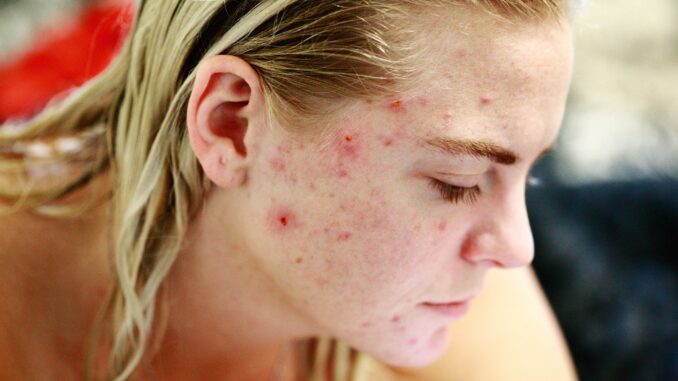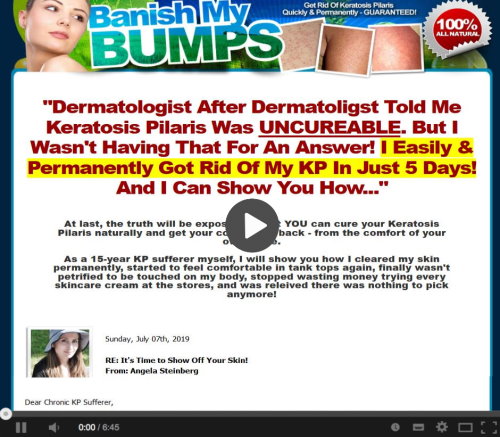
Most of the time, we don’t understand what exactly our skin wants, and sometimes we keep on opting for the wrong products. We get baffled about various skin conditions and never get the correct solution for them.
We can all agree that any skin issues are irritating. Even if you’ve made progress to clear your skin of breakouts, other issues can leave you with flawed skin for months or even years after. One of which is the Keratosis Pilaris. Keratosis Pilaris on the face is less common, but how can we deal with it?
What is Keratosis Pilaris
Keratosis pilaris sometimes called “chicken skin” is a common skin condition that causes patches of rough-feeling bumps to appear on the skin. These tiny bumps or pimples are dead skin cells plugging hair follicles. They sometimes appear red or brown.
Keratosis pilaris is commonly found on the upper arms, thighs, cheeks, or buttocks. It isn’t contagious, and these bumps don’t usually cause any discomfort or itching.
This condition is known to worsen in the winter months when the skin tends to dry out, and may also worsen during pregnancy. Keratosis pilaris isn’t contagious. Out of the many different types of skin bumps and growths that are possible, keratosis pilaris is a harmless one.
Is There Anything I Can Do About Them?
Like acne, keratosis pilaris is a lot more common around puberty. Nevertheless, there’s no cure for this harmless, genetic skin condition, but there are some ways to treat it or prevent it from getting worse. Improvement may take months if the condition enhances at all. It will typically clear up naturally by the time you reach 20 to 30 years old. Of course, you’ll look at someone who failed both of those metrics, so it’s not a guarantee. Fortunately, with the right products, you can likely lessen the appearance of your keratosis pilaris within a month, if you’re consistent with a daily regimen.
How to Treat Keratosis Pilaris on Face?
Because keratosis pilaris isn’t harmful, you usually don’t need to treat it. Although it doesn’t hurt or itch, some people feel embarrassed about it. Hence, if the bumps bother you, treatment with moisturizers, creams and gentle skincare may help your symptoms. However, please know the intensity of Keratosis Pilaris can ebb and flow throughout life. This is mainly thanks to hormones or life stages such as pregnancy.
The approach to treating keratosis pilaris can be very similar to treating acne. The best treatment is a combination of exfoliation and skin nourishment. You never want to over-process your skin, use harsh ingredients or be rough with your skin.
Here are some things you can try to lessen the appearance of keratosis pilaris on your face. Be sure to keep your eye out for a few ingredients to use:
- Use a sulfate-free face wash morning and night. Dealing with Keratosis Pilaris should be 90% moisture and 10% exfoliation so, using products like this on the face would help improve your skin condition. It will hydrate and soften, especially if products are enhanced with ceramides and hyaluronic acid.
- Use a gentle, exfoliating facial cleanser that is formulated with glycolic acid. Use something fragrance-free and full of emollient ingredients that might help hydrate your skin and stop it from feeling so dry. Less is more when treating Keratosis Pilaris. Patients routinely try to excessively exfoliate their face with harsh scrubs, making the redness and dryness even worse. Physical scrubs are a major no-no for the more sensitive skin of your face, so look for exfoliating-acid active ingredients.
- If you’d prefer to incorporate your acids using a leave-on product, use a gentle lactic acid serum every other night as tolerated and then increase to nightly use. Use only the gentlest of acids, never scrub, and keep your skin as moisturized as possible. Since this product may cause some dryness, layer a hydrating lotion on top. A serum applied to clean skin post exfoliation will help give you next-level results.
- After applying an acid, you’ll want to follow up with an “intense hydrator,” that is ideal for treating dry skin associated with keratosis pilaris. Creams containing colloidal oatmeal and shea butter can offer soothing hydration to the skin. They absorb quickly and offer immediate and long-term hydration for dry, sensitive skin. Make sure to use thick cream or very viscous body oils rather than lotions because these more effectively seal hydration into the skin. The best time to moisturize is right after a shower when the skin is warm and damp and will absorb the moisture.
- For keratosis pilaris on the face, several dermatologists highly recommended adding a retinoid to your routine. Retinoids are also a powerful and effective chemical exfoliator that is highly beneficial in the treatment of keratosis pilaris. Retinoids speed cell turnover and exfoliate the top layer of your skin. In addition to treating Keratosis Pilaris, retinoid has been highly recommended by dermatologists to tackle a range of skin conditions, including acne, discoloration, and scarring, so it’s a particularly great option if you have more than one skin concern you’re trying to treat. Women who are pregnant, nursing, or may become pregnant should avoid topical retinoids.
- Don’t pick. We understand the urge to try and pop or pick at the tiny little pimples, but please don’t. It will not help at all clear your skin. Squeezing or picking at Keratosis Pilaris causes worse effects like irritation, redness, and the potential for scarring as well
- If you continue to see bumps or patches on your face and want to camouflage them, try a multi-purpose product like BB Creams. This will soothe blemishes, reduce redness, hydrate the skin, and conceal imperfections.
While these tips will help treat and clear keratosis pilaris there are severe cases that do not respond as well or quickly as others. If your skin is not getting better fast enough, you may want to consider professional treatments such as diamond peels and chemical peels.












Thanks for every other magnificent article. Where else could anyone get that type of information in such a perfect way of writing? I have a presentation subsequent week, and I’m on the look for such info.